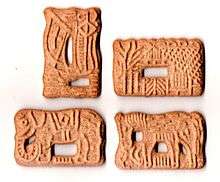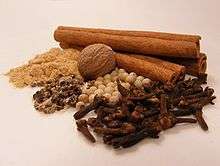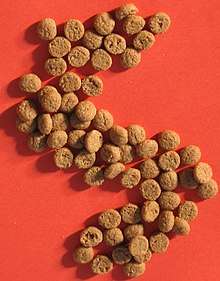Speculaas
Speculaas or speculoos (Dutch: Speculaas Dutch pronunciation: [speːkyˈlaːs], Belgian-Dutch: speculoos, French: spéculoos French pronunciation: [spekylos], German: Spekulatius) is a type of spiced shortcrust biscuit, traditionally baked for consumption on or just before St Nicholas' day in the Netherlands (5 December), Belgium (6 December),[1] Luxembourg (6 December), and around Christmas in Germany and Austria. Speculaas are thin, very crunchy, caramelized, slightly browned and, most significantly, have some image or figure (often from the traditional stories about St. Nicholas) stamped on the front side before baking; the back is flat. Speculaas also found in Indonesia and locally known as spekulaas or spekulaas koekjes. In Indonesia, this dish usually served during Christmas or other occasion.[2][3]
 | |
| Alternative names | Windmill cookies |
|---|---|
| Type | Shortbread cookie, Biscuit |
| Place of origin | The Netherlands |
| Main ingredients | Flour, sugar, butter, pepper, cinnamon, ginger, cloves, cardamom, nutmeg |


Speculaas dough does not rise much. Dutch and Belgian versions are baked with light brown (sometimes beet) sugar and baking powder. German Spekulatius uses baker's ammonia as leavening agent. Spices used in speculaas are cinnamon, nutmeg, cloves, ginger, cardamom, and white pepper; these were common in the 1600–1700s due to the Dutch East Indies spice trade. Family recipes may also include small amounts of other spices like anise, etc. Traditionally, speculaas were made from Frisian flour and spices. The name speculoos was coined for Belgian wheat flour cookies with hardly any spices. Today most speculaas versions are made from white (wheat) flour, brown sugar, butter and spices. Some varieties use some almond flour and have slivered almonds embedded in the bottom.[1]
The dough is prepared by beating butter, sugar and spices and combining them. The flour and leavening agent are mixed separately and then added. Bakers are careful not to overwork the dough, so it will rise slightly. The dough is stored in a cool place overnight to give the spices time to permeate the dough and add extra flavor.
Name
There are several interpretations for the origins of the name speculaas. It may derive from Latin speculum, which means mirror and refers to the fact that the images are cut as a mirrored bas-relief into a wooden stamp, which is then used to decorate speculaas. Another, less likely, word origin refers to the Latin word speculator which, among other meanings, could refer to a bishop or St Nicholas' epithet, "he who sees everything". Still another possible source is Specerij, the Dutch word for spice.
A variant of the Dutch speculaas is the Belgian speculoos. Less spices are involved in the process of making Belgian speculoos compared to the Dutch speculaas, as the spices were much more expensive to import to Belgium as opposed to the Netherlands. Belgian speculoos was developed in the 20th century around the area of Verviers, and made as an alternative for people Who couldn't afford the real Dutch speculaas. [4]
Derivative varieties
The Belgian city of Hasselt is known for a local variety of speculoos. On 13 January 1870, Antoine Deplée, a baker from Hasselt, acquired a licence for Hasselt speculoos: "une espèce de pain d'amandes connu sous le nom de spéculation" ("a kind of almond 'bread' known under the name spéculation"). He sold this version locally and abroad.
The German Spekulatius, traditional in Westphalia and the Rhineland, is similar. It is popular throughout the country around Christmastime and usually not available at other times of the year.
Brands
In Europe, Lotus Speculoos is the most recognized brand. In the United States and United Kingdom, the same company is branded as Lotus Biscoff. Several chains of supermarkets have started their own product under their generic name. Speculaas is often produced under local bakeries' brand names as well.
In the United States, California-based variety grocery store chain Trader Joe’s sells their own select brand of cookie butter, a thick buttery paste made up of the cookies, as well as their own cookie butter ice cream.
Spread or paste variant
By 2007, several Belgian companies began marketing a paste variant of speculoos, now available worldwide under various brands and names: as Speculla, Cookie Butter, Biscoff Spread. As a form of spreadable Speculoos cookies, the flavor is caramelized and gingerbread-like, with a color similar to peanut butter[5] and a consistency ranging from creamy to granular or crunchy. The spread consists of 60% crushed speculoos cookies along with vegetable oils.[5][6]
Workers in the Low Countries traditionally made a sandwich in the morning with butter and speculaas or speculoos cookies. This would develop into a spread-like consistency by lunchtime.[1][6] In 2008, two competitors entered a contest on the Belgian television show, The Inventors (de Bedenkers), with a spread made from speculoos cookies[6][7] — Els Scheppers, who reached the semi-finals, and the team of chef Danny De Mayer and Dirk De Smet, who weren't selected as finalists. Spreads made from crushed Speculoos cookies would subsequently go into production by three separate companies and become popular.
See also
- Cookie butter
- Ginger biscuit
- Kruidnoten, a thicker, harder biscuit made without molds with the same ingredients
- Springerle, a thicker, anise-flavoured, moulded Christmas biscuit from Germany
References
- "What You Need to Know about Speculaas Cookies". About.com Food. Retrieved 2016-01-14.
- "Resep Kue Zaman Penjajahan Belanda". i idntimes. Retrieved 26 May 2020.
- Roti Legendaris Peninggalan Belanda yang Jadi Makanan Khas Indonesia || OMIYAGO
- https://royale.nl/nl/actueel/item/17-speculaas-vs-speculoos
- "Speculoos Cookie Butter". Trader Joe's. Archived from the original on 2013-01-31.
Speculoos Cookie Butter is, in its most simplistic terms, spreadable Speculoos cookies. Speculoos cookies are classic Belgian cookies with great crunch, and a slightly caramelized, almost-but-not-quite-gingerbread flavor. After the cookies are baked to a fabulous finish, they’re crushed into a fine powder and mixed with magical ingredients (read: vegetable oils) and turned into a smooth, spreadable substance we call Cookie Butter. It resembles peanut butter in color and consistency.
- Castle, Steven (February 15, 2011). "A Cookie Paste Squeezed in the Middle of a Debate". The New York Times.
In an earlier era, blue-collar workers used speculaas and speculoos as a sandwich filling (cheaper than cheese or meat) between pieces of buttered bread. By lunchtime the cookies would have softened into a paste.
- "Belgian's popular bread spread not [sic] longer protected". Wolters Kluwer Law and Business. February 2011. Archived from the original on 2015-06-23. Retrieved 2016-04-08.